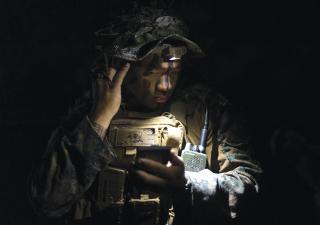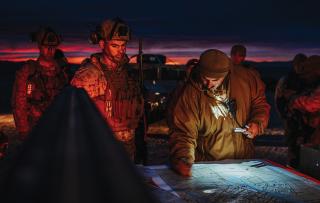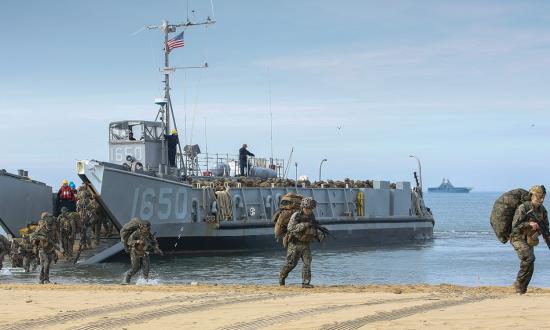The Marine Corps should incorporate a light infantry force or develop light infantry-capable elements within the infantry battalion force structure. In this regard, the Russia-Ukraine war offers lessons the Marine Corps should consider. The Russian logistical failure shows that overreliance on logistics can immobilize a large force. Ukrainian small-unit tactics have demonstrated that in some circumstances a small force can devastate a numerically and technologically superior enemy. In other words, a versatile force capable of outmaneuvering the enemy can be built around a logistically independent and small light infantry force.
What Makes Infantry Light?
Some Marines might argue the Marine Corps is already a light infantry force, so incorporating it as a specialization would be pointless. This is a common misunderstanding.
A U.S. Army Command and General Staff College survey by Major Scott McMichael concluded that such forces are physically light—with no organic heavy weapons such as tube artillery—but still employ tactics, techniques, and procedures similar to those of a conventional (nonlight) counterpart.1 In contrast, European forces consider light infantry to be a tactically agile force that uses outside-the-box thinking, employs unconventional tactics, and is logistically self-reliant.
Many historical examples suggest the proper use of a light infantry force. The Army survey looks closely at British Major General Orde Wingate’s Chindit special operations units in Burma during World War II. The Chindits (an Anglicization of the Burmese word for lion) created maximum damage and confusion for the Japanese by attacking logistics hubs, harassing rear units, and cutting communications.2 Marine Raiders, too, showcased the value of light infantry in combat against the Japanese, using small-unit tactics, ambushes, and raids against a numerically superior enemy.
These examples teach that, to destroy the enemy’s ability to operate coherently, a force employed in small elements harasses rear units, attacks logistical hubs, ambushes enemy forces, raids lightly defended installations, and ultimately causes fatal confusion. Though being physically light is an important element, a force’s ability to be tactically agile is essential. Also vital are the characteristics of individual infantrymen—self-reliance, confidence, and versatility—and a combination of speed, surprise, and violence.
McMichael describes self-reliance as the fountainhead from which all other characteristics flow. It is displayed by resourcefulness and the willingness to complete the mission with whatever is on hand regardless of enemy superiority by numbers or assets. A lack of logistical support does not hamstring a self-reliant force. Instead, Mao Zedong’s Guerrilla Warfare says a light force can depend on the locals for food and the enemy for weapons and ammunition.3 Light infantry must be confident to complete any mission, which will make the enemy much more hesitant and prone to mistakes.
Light formations must be versatile, adapting to any environment, situation, and enemy. They are not tied to black-and-white tactics, techniques, procedures, or doctrine. Instead, they rely on their imaginations and decision-making ability to bend the enemy to their will. Finally, speed, surprise, and violence of action—three tenets of every infantry Marine—are used in their most literal sense. Though light infantry employment has limitations, its characteristics define a force that can destroy the enemy without outside support, allowing conventional units to complete their tasks more effectively. In short, both infantry types have complementary roles to play.
Infantry Marines familiar with the current table of organization and method of employment would resoundingly say the Marine Corps is not a light infantry force. Instead, it is line infantry, defined as troops that rely on formations, ratios, and supporting arms to complete their mission. Specifically, line infantry relies on indirect fires and supporting agencies to help shape the battlefield (see Marine Corps Doctrinal Publication [MCDP] 1: War-fighting), whereas light infantry will adapt to the enemy situation and develop a plan based on what is readily available, however unideal.
For example, a traditional Marine rifle company in a Range 400 exercise at Marine Corps Base Twentynine Palms will endeavor to reach the limit of advance and destroy the platoon/company that occupies that ground. In contrast, a light infantry company would avoid direct engagement, probably conducting night attacks from multiple directions using stealth to get close and employing mass surprise fires to destroy the enemy. The light infantry unit would continue these types of attacks until the opponent decided holding the terrain had become untenable, making the opponent even more vulnerable during withdrawal.
Light Infantry Employment
Light infantry can be effective against any enemy, so long as it is not used as line infantry. Special attention should be given to unit size, however. Light infantry can be employed in larger formations—company-size and higher—but those formations should be understood as fighting multiple isolated engagements simultaneously (platoon-size and smaller).
Just as with Marine Corps line infantry, most light infantry actions occur at the squad level, as larger elements can hinder speed and efficiency. While platoons can mass fire more efficiently than squads, light infantry values the precision and effectiveness of individual fire to inflict the most casualties in the least possible time rather than simply to gain fire superiority. In addition, rapid egress following an ambush on a larger force is the principal way to avoid being overrun. A squad, which is easily controlled by voice commands, requires much less coordination than a platoon for the same activity.
Tasking light infantry units demands some special consideration, however. Mao wrote: “There are differences also in the matter of leadership and command. In guerrilla warfare, small units acting independently play the principal role, and there must be no excessive interference with their activities.” Tasking statements for light infantry should differ from traditional ones, being open-ended, mission-type orders that permit tactical freedom of movement and allow small-unit leaders to make the best decisions.
Light infantry units are often well suited to conducting offensive actions against the enemy, even if they are not necessarily the decisive factor in a given operation. They can shape the battlefield and protect friendly forces by destroying supporting agencies, probing enemy defenses, damaging communications and logistics, and gathering information on enemy weaknesses. They can protect friendly movements by conducting counterambush actions ahead of the main body or even ambushing enemy forces attempting to reach the main body.
Not to be confused with reconnaissance, snipers, or scouts, light infantry should not be used on the defensive line during defensive operations. Instead, it would be best employed forward of the main battle area in small elements tasked with destroying the enemy’s capability to rest, resupply, communicate, and think. It should be used as an extension of the heavy-medium-light method of engagement (HAW-MAW-LAW; see Marine Corps Infantry Publication 3-10A.3:i Marine Infantry Platoon, appendix C).
MCDP-1 describes using a counterpunch during defensive operations; light infantry should be used as a flurry of counterpunches targeting multiple enemy vulnerabilities. Mao again:
Avoid the solid, attack the hollow; attack; withdraw; deliver a lightning blow, seek a lightning decision. When guerrillas engage a stronger enemy, they withdraw when he advances, harass him when he stops, strike him when he is weary, pursue him when he withdraws. . . . The enemy’s rear, flanks, and other vulnerable spots are his vital points, and there he must be harassed, attacked, dispersed, exhausted, and annihilated.
In unconventional conflicts, light infantry should possess a Jäger mindset—a hunter’s. When unconventional conflicts pit lesser-armed irregular forces against technologically advanced militaries, the latter often fail despite overpowering the indigenous fighters. In Afghanistan, the Marine Corps physically dominated the Taliban but did so at great cost to the local populace through collateral damage and destruction of private property, which ultimately did nothing to curb the existence of the Taliban or defeat the insurgency. Despite facing overwhelming firepower, fewer numbers, and aged equipment, the Taliban outlasted U.S. forces by employing small, disaggregated units and outmaneuvering the slower line infantry.
Brigadier General Samuel Griffith, who commanded the 1st Raider Regiment in World War II and originated the Small Wars Manual, advocated for introduction of light forces within the Marine Corps. He feared that numerous postwar insurgencies would arise and that the U.S. response would be as unsatisfactory as it had been in Nicaragua, where he says the poorly equipped Sandinistas embarrassed thousands of Marines for six years.4 He believed light infantry should bring as much chaos and destruction to the enemy as possible, embedding itself within the environment, ambushing enemy movements, and degrading enemy morale.
Why is Light Infantry Relevant?
Force Design 2030 has been instrumental in introducing new concepts to the Marine Corps. If stand-in forces are required to operate during a conflict within the enemy’s long-range weapons engagement zone (WEZ), they will need to be self-reliant.
If the stand-in force needs not merely to persist but to fight, light infantry would be much better suited than line in environments that lack outside support. The new infantry battalion table of organization and equipment considerably lightens available assets, but a gap remains in the Force Design structure’s capability. Much of its employment focuses on protecting the rocket and missile batteries. When called on to conduct core infantry tasks, many of the new companies must revert to legacy formations and employment, increasing the required enablers and outside supporting agencies.
Light infantry is a necessary addition rather than hindrance to Force Design. If conflict breaks out in the South China Sea, China will seize as many strategic locations as possible to extend the People’s Liberation Army’s (PLA’s) reach. However much better suited conventional Marine infantry would be—force on force—to prevent Chinese forces from seizing territory, they would be a much more tempting target for the PLA Navy (PLAN). A small and self-reliant unit, on the other hand—even one focused on indirect targeting of enemy shipping and harassing enemy forces—would be a much less worthwhile target.
Force Design’s construct falls short regarding harassment because of the significant need for outside agency support. While enablers provide important capabilities, after crossing the line of departure their ability to enable the company becomes limited. Light infantry, by contrast, remains self-reliant, meeting its logistical needs from the environment and local population. It also employs its forces unconventionally, using 60-mm mortars in the handheld mode, M3E1 recoilless rifles, medium machine guns, and demolition charges, not all of which are currently available to squad leaders.
More than Just WestPac
Even if no conflict in the South China Sea ever erupts, conflicts elsewhere have demonstrated the necessity of light infantry. The Russia-Ukraine war has shown the importance of self-reliance and the efficiency of small-unit tactics against a numerically superior force.
During Russia’s initial invasion, Ukrainian forces were quickly routed. Recognizing their inability to face the Russian war machine on even terms, they resorted to unconventional tactics that employed small teams with antiarmor weapons such as Javelins and man-portable surface-to-air missiles. Videos show the Russian Sixth Guards Tank Regiment being routed by a small Ukrainian unit with antitank weapons and Russians being harassed with loitering munitions and random mortar fire.
The ability to operate in an electronically degraded environment has become a necessity in modern war, something else the Russia-Ukraine war has shown. A self-reliant force must be capable of operating in degraded environments against a not only numerically but also technologically superior enemy. As Mao summarizes it: “There is in guerrilla warfare no such thing as a decisive battle; there is nothing comparable to the fixed, passive defense that characterizes orthodox warfare.”
Assembling the Pieces
It could be argued that the Marine Corps already possesses light infantry in the form of special operations troops such as the Marine Raider Regiment. But special operators are not infantry, and light infantry are not elite troops. In any case, the Marine Corps cannot supply every infantry battalion with special operators.
Light infantry units should work in concert with, not in place of, line infantry. Organizationally, this suggests two approaches. The first would be to include one light rifle company per battalion. The second would be to include one light infantry battalion per regiment, attaching one light company to a line battalion during the workup and deployment.
The first arrangement would make light infantry organic to every battalion, giving the battalion commander full control of the light company. However, staffing the company could prove difficult, and maintaining training and readiness standards could be an issue for those less experienced in employing light infantry.
The second method would ensure integrated training standards are maintained, but integration with line battalions might prove challenging and require longer workups. The light company would be beholden to two sets of training standards, one each from the lending and receiving battalions. Manning also could be difficult.
However the units are attached, light infantry training should be demanding and should emphasize small-unit actions. With limited logistical support, Marines will have to learn how to purify water, forage, hunt, and fish. And the Marine Corps also should reemphasize the importance of survival schools and increase funding for specialized schools such as Combat Hunter and the Mountain and Jungle Warfare Training Centers.
In an austere environment inside the WEZ, Marine Corps light infantry units would only enhance the capability and efficiency of the changes already begun under Force Design 2030.
1. MAJ Scott R. McMichael, USA, A Historical Perspective on Light Infantry (Ft. Leavenworth, KS: U.S. Army Command and General Staff College, 1987).
2. FM William Slim, BA, Defeat into Victory (London: Cassell and Co., 1956).
3. Mao Tse-tung, On Guerrilla Warfare, trans. BrigGen Samuel Griffith III, USMC (Ret.) (New York: Praeger, 1961).
4. Mao Tse-tung, On Guerrilla Warfare.










